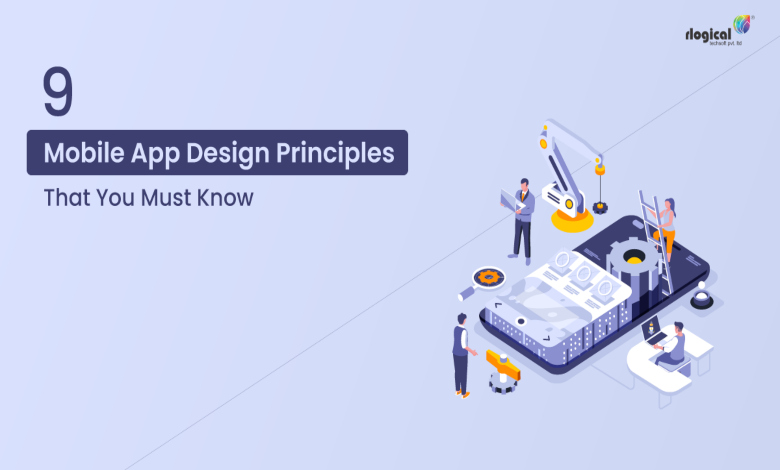9 Best Mobile App Design Principles That You Must Know
A Complete Guide to Great Mobile App Design Principles

In present times, people are spending more time on phones, which has become a part of everyday lives. Among all these times they engage with phones, most time is spent on apps or websites. Any mobile app design becomes good or bad depending upon the user experience or UX’s quality. The better the UX, the higher the quality. Nowadays, users’ expectations are quite high from the app. So, mobile app development companies should consider making impressive user interfaces or UI and spectacular UX to grab users’ interest. These are essential product strategic components.
While designing mobile apps, it is always important to remember that the apps need to be intuitive and useful. If the app does not add any real value, people will have no reason to use it. Moreover, it needs to be effortless and less time-consuming for learning. User-centric apps are required to be developed as they will solve the problems of people. The key goal for designers should be to focus on users’ needs and eradicate the obstacles while making the app of good quality. Here are certain designs principles to follow for making apps that provide a great user experience.
Top Key Mobile App Design Principles to Make Apps Outshine
1. Decluttering
The attention of users is precious, and it needs to be allocated to good content. Cluttering UI overloads users with a bit too much information like images, one text line, and added button makes it look a lot more complicated. By limiting the clutter, one can surely enhance the app and improve comprehension.
The minimalism technique can help in dealing with the cluttered UI problem. For that, mobile app design services companies should keep all the content as minimum as possible. Keep only those that are essential for users to know. Also, make sure to keep the elements of the interface very little. The simpler the design, the better experience user will have with the products. Moreover, one can also use the progressive disclosure technique to show more options.
2. Swift Loading
Users demand immediate results and have less patience for staying in apps that takes a lot of loading time. Within few seconds, people need the results to be displayed. Today, the internet has improved way more, so users’ demand increased immediacy. Otherwise, they will quickly shift to any other app that delivers instant results.
If you want users to have the app on their devices, you need to speed up the loading time. Those who hire mobile app developer also expect that users have the best experience and the loading speed of the app becomes highly important for that. You can limit loading time by minimizing re-directs and HTTP requests to keep all these response times of the server in check.
In addition, concentrate on the loading of content first. Content needs to be displayed at the beginning of the page so that users take time to read the initial results. Subsequently, subsequent content will be loaded in the background and becomes available when the user scrolls. Utilize clever animation for retaining the attention of users. Optimize and resize images for faster loading.
3. Simple and Frictionless Registration
Most of the time, an app requires the registration of users to provide them a customized experience while increasing conversions. Forcing users to give their details immediately after they enter your app can lead to distraction and discomfort. They use the app to browse, purchase or get information about anything. Mobile app development companies need to focus on users’ trust that they will solve their problems before giving any personal information.
Registration forms raise the errors possibilities, unmatched passwords, etc., which can drive users away. Applications that usually do not move forward without email and its password are mostly dropped. Apps having complex password processes also fail to grab the interest of the users. To make the registration process better, provide context while asking for any personal details and asking for the least permissions.
4. Decrease Cognitive Load
A lot of options or questions, or information can increase the users’ cognitive load. People use the apps to make lives simpler, so they do not need to go through education to use the app. Cognitive load reduces the purpose of the app. The app should contain intuitive graphics rather than a lot of text. Mobile app design services companies should remember that a minimal design with a smooth user experience will make the app shine from the rest. Include only the essential elements to decrease the cognitive load. Also, use subtle animation and avoid flashy designs.
5. Making Navigation Intuitive
Users must have the ability to navigate across the app through clear pathways. They should get access to complete primary work without the need for any explanations. Users lack patience if there are complex steps. If it takes a lot of time or effort to learn how to navigate, they may lose interest.
Users should be able to finish the task in one app. It is better not to push users to switch different pages to get something completed. Keep the process simple and all information readily available. During navigation, the users should know how they went there and what they will be doing next.
6. Make Finger-Friendly Designs
Small touch targets are difficult for people to hit. This is the reason for keeping larger icons while designing interfaces. Create controls with a size of 7-10 mm, which will be easier to tap with fingers. Such a target also allows fitting the finger perfectly. Moreover, ensure that a nice amount of space is kept between targets.
7. Visible Interface Elements
Users can also use their mobile devices outdoors, even in poorly lighted areas. It is essential to design a color contrast in the interface elements for helping users to view or use the app in any condition. For text elements, ensure that there is sufficient contrast between background and font color. Small texts can have a ratio around 4.5:1 ratio against the background, and large text is advised to be at least a 3:1 contrast ratio.
8. In-App Search
An in-app search is quite useful. Such features are often overlooked. Most users look for something specific and want the results immediately. So, an in-app search is best for making an app better.
9. Test the Design
People who hire mobile app developer to design their apps want it to be satisfying to the users. But most good designed app looks great, but after interacting, it feels unpleasant. So, it is essential to test the app through real users. You should ask some users to do some tasks and ask them the way the design performs. If you find problems while testing, then you can easily fix them.
Conclusion
A great design is a perfect blend between functionality and beauty, and this is what one should aim for while creating an app. The user’s journey should begin with a crisp flow of onboarding, easy navigation, and a smooth and intuitive interface to provide an excellent user experience. Delivering good quality results enhances users’ engagement, and for that, a good design is necessary.



